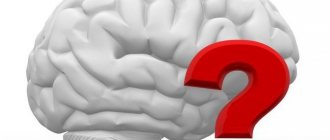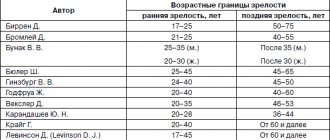Basic approaches to the problem of the crisis of adolescence
Chronologically, adolescence is defined from 10-10 to 14-15 years. Teenager - (10 - 19). The hero of Dostoevsky’s novel “The Teenager” turned 20 years old, and Tolstoy considered the age of 15 years to be the boundary between adolescence and youth. Otrok - “not having the right to speak”, the meaning of this word is slave, servant. This concept emphasizes the social status of a person. The main feature of this age is sudden, qualitative changes affecting all aspects of development. The process of anatomical and physiological restructuring is the background against which a psychological crisis occurs. The activation and complex interaction of growth hormones and sex hormones causes intensive physical and physiological development. The height and weight of the child increase, and in boys, on average, the peak of the “growth spurt” occurs at 13 years of age, and ends after 15 years, sometimes continuing until 17. In girls, the “growth spurt” usually begins and ends two years earlier (further, more slow growth may continue for several more years). Changes in height and weight are accompanied by changes in body proportions. First, the head, hands and feet grow to “adult” sizes, then the limbs—the arms and legs lengthen—and lastly the torso. Intensive skeletal growth, reaching 4-7 cm per year, outpaces muscle development. All this leads to some disproportion of the body, teenage angularity. Children often feel clumsy and awkward at this time. Due to rapid development, difficulties arise in the functioning of the heart, lungs, and blood supply to the brain. Therefore, adolescents are characterized by changes in blood pressure (blood pressure), increased fatigue, and mood swings; hormonal storm => imbalance. This state was successfully expressed by an American teenager: “At the age of 14, my body seemed to go crazy.” Emotional instability increases the sexual arousal that accompanies the process of puberty.
The problem of leading activity in adolescence
The leading activity of a teenager is communication with peers. The main trend is the reorientation of communication from parents and teachers to peers. 1) Communication is a very important information channel for teenagers; 2) Communication is a specific type of interpersonal relationship; it develops in a teenager social interaction skills, the ability to obey and at the same time defend their rights.; 3) Communication is a specific type of emotional contact. Gives a feeling of solidarity, emotional well-being, self-esteem. Psychologists believe that communication includes 2 contradictory needs: the need to belong to a group and to be isolated (their own inner world appears, the teenager feels the need to be alone with himself). A teenager, considering himself a unique person, at the same time strives to be no different in appearance from his peers. A typical feature of teenage groups is CONFORMITY
-
a person’s tendency to assimilate certain group norms, habits and values, imitation . The desire to merge with the group, not to stand out in any way, which meets the need for security, is considered by psychologists as a mechanism of psychological defense and is called social mimicry.
General psychological characteristics of adolescence
Adolescence is a period of transition from childhood to adulthood, a life stage during which a child gradually develops into an adult. That is why adolescence is also called transitional age.
Different literary sources indicate different boundaries of adolescence: if regarding the lower limit of this age, the opinions of the authors almost coincide and the age of 10-11 years is considered its beginning, then the upper limit of adolescence is indicated from 15-16 [20; 40] up to 19 years of age [29]. The boundaries of adolescence are different for boys and girls: the beginning and end of the transition period for girls occurs on average one to two years earlier than for boys [32].
The main feature of adolescence is profound qualitative transformations that affect all aspects of the child’s development.
Outstanding Russian psychologist L.S. Vygotsky identified two series of processes in the structure of adolescent development: natural and social. “The natural series is characterized by the processes of biological maturation of the organism, including puberty, the social series is the processes of learning, education, socialization in the broad sense of the word. These processes are always interconnected, but not parallel” [20]. The rates of biological and social development of a teenager do not coincide, and the rates of development of various aspects of the same series do not coincide: for example, individual systems of a teenager’s body mature at different times. “There are even more variations in the psyche: an older teenager may be already an adult in some respects, and still a complete child in others. The layers of childhood in him intricately coexist with the layers of adulthood. Children’s whims and attitude towards others strangely coexist in him with adult judgments” [20].
In adolescence, every child faces an extremely difficult task: to adapt to a huge number of deep and comprehensive changes occurring in his body, psyche and social status. Solving such a problem would not be easy even for an experienced and mature adult. It’s even more difficult for yesterday’s child. That is why adolescence is rightly called difficult and critical [5].
The already difficult situation of adolescents is aggravated by the fact that in modern society there is a large gap between the demands placed on adults and children: “They demand obedience from a child, initiative and independence from an adult. The child is protected in every possible way from issues of gender, but in the lives of adults, the relationship between men and women plays an important role. The contrast between childhood and adulthood, between which he “lies,” makes it difficult for a teenager to learn adult roles and gives rise to many external and internal conflicts” [20].
In addition, modern conditions contribute to the aggravation of the uneven transition of a teenager from childhood to adulthood: “This is due to the fact that in the life circumstances of modern schoolchildren there are moments of two kinds: 1) inhibiting the development of adulthood (children are busy only with studying in the absence of most other permanent and serious responsibilities, the tendency of many parents to free children from everyday work, worries and sorrows, to take care of everything); 2) maturing moments (huge flow of information, acceleration of physical development and puberty, high employment of many parents and, as a possible consequence of this, early independence of children)” [5].
Therefore, many modern teenagers fail to fully cope with the difficulties of the transition period. As a result, various behavioral deviations (deviant behavior) often arise in adolescence, such as aggressive manifestations, conflicts with adults and peers, fights, smoking, alcoholism and drug addiction, suicide attempts, etc. [39]. Internally, adolescents often experience emotional imbalance, anxiety, uncertainty, distrust of people, a tendency to depression, etc. [18].
The main new development of adolescence is the sense of adulthood characteristic of adolescents [4]. The teenager realizes that he is no longer quite a child and strives to become an adult as soon as possible. He wants to be independent and independent, and even more wants others to perceive him as an individual. If parents, teachers and other adults continue to treat a teenager as a child, he will protest, and this protest can take many different forms.
The feeling of adulthood among adolescents has many external manifestations. Most often, teenagers begin to imitate adults in their behavior, communication and appearance. He can imitate both the negative characteristics of adults (smoking, swearing, etc.) and positive ones (caring for others, participating in various activities on an equal basis with adults, etc.). Changing different role models, a teenager “tryes on” different social roles, and as a result, as a rule, sooner or later finds the ones most suitable for him [4; 24; 40].
Let us consider the typical changes occurring in the psychological sphere of a teenager in more detail. During this period, all cognitive processes develop and reach the adult level: “the period is characterized by the formation of selectivity, purposefulness of perception, the formation of stable voluntary attention, logical memory and theoretical thinking” [42]. Along with the development of cognitive processes, the abilities of adolescents also develop: in adolescence, learning, intelligence and creativity (creative abilities) reach their maximum level [20].
The emotional and volitional sphere of adolescents undergoes significant transformations: “Strong-willed character traits - perseverance, perseverance in achieving goals, the ability to overcome obstacles and difficulties - acquire noticeable development during this period. Unlike a primary school student, a teenager is capable not only of individual volitional actions, but also of volitional activity. He often sets goals for himself and plans their implementation himself. But the lack of will is reflected, in particular, in the fact that while showing persistence in one type of activity, a teenager may not show it in other types. Along with this, adolescence is characterized by a certain impulsiveness. Sometimes teenagers will do it first and then think, although they already realize that they should have done the opposite. ... The feelings of teenagers are rapidly developing. Their emotional experiences become more stable. Under the influence of the environment, the worldview of adolescents, their moral beliefs and ideals are formed. Moral feelings of patriotism, internationalism, responsibility, etc. take shape and develop. This age is also characterized by complex aesthetic feelings, the formation of an aesthetic attitude towards the surrounding reality” [20].
The motivational sphere of adolescents is changing. The cognitive need becomes as pronounced as possible, both in relation to the surrounding reality and in relation to oneself. In an effort to understand the world around him, a teenager experiences interest in one or other phenomena and activities, and as a result, his personal and professional interests are formed. Being emotionally involved in the process of cognition of the surrounding reality, the teenager shows a moral attitude towards all phenomena that are in the focus of his attention. As a result, he develops life ideals, beliefs, worldview [3] and, by the end of adolescence, the character and orientation of the individual.
At the same time, the teenager experiences a deep interest in his own personality: “The answer to the question “Who am I?” often torments a teenager. He shows interest in himself, he forms his own views and judgments; own assessments of certain events and facts appear; he tries to evaluate his capabilities and actions, comparing himself with his peers and their actions” [34]. A teenager’s ideas about himself are formed through comparing himself with others, perceiving ratings given to him by peers and adults, and through reflection (self-analysis) [20; 40]. As a result, during the transition period, the self-concept of the individual is fully formed, which is considered another main new formation of adolescence.
In this regard, the desire for self-knowledge, self-expression and self-affirmation are the main motivational lines of adolescence [24]. All of the above motives are realized in adolescents in communication with peers, and therefore the leading activity of adolescents is communication with peers [4].
Thus, adolescence is one of the most difficult and at the same time responsible stages in a person’s life: it is during this period that, under conditions of increased complexity, the foundations of a person’s personality are formed.
Next: Teenager and society: socialization of a teenager








